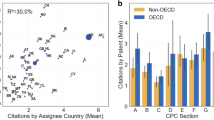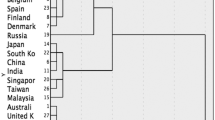Abstract
This paper examines to what extent research and development (R&D) capabilities have geographically disseminated and dispersed worldwide, analyzing scientific papers and patents as R&D outputs. As a result, global dispersion was revealed using Lorenz curve and Gini Coefficient, in the main field of scientific journals from INSPEC; Physics, Electrical Engineering, Electronics, computer and control engineering including Information Technology, and Mechanical engineering. In the case that we examine foreign invented US patents excluding domestically invented patents in the US, we can see geographical dispersion among nationalities since 1990, among others, much more than all the US patents including domestically invented patents in the US. Herfindahl-Hirschman (HH) indicator also shows the decline in the degree of the concentration ratio. The results obtained in this paper is that the number of nationalities of authors’ affiliation and that of nationalities of affiliations of U.S. patent inventors have increased and diversified. Especially, R&D capabilities measured by nationalities of authors’ affiliation remarks that point, rather than by those of US patent inventors, which means that more and more countries have improved R&D capabilities, “R” in particular.
Access this chapter
Tax calculation will be finalised at checkout
Purchases are for personal use only
Similar content being viewed by others
References
Akashi, Y., & Ueda, H. (1995). Nihon kigyou no kenkyu-kaihatsu sisutemu (R&D system of Japanese Companies), Tokyo: Tokyo University Press.
Archibugi, D., & Michie, J. (Eds.). (1997). Technology, globalization and economic performance. Cambridge: Cambridge University Press.
Asakawa, K. (2011). Gurobaru R&D manejimento (global R&D management). Tokyo: Keio University Press.
Badaracco, J, Jr. (1990). The knowledge link: How firms compete through strategic alliances.
Cantwell, J. A. (1995). The globalization of technology: What remains of the product cycle model? Cambridge Journal of Economics, 19(1), 155–174.
Freeman, C., & Hagedoorn, J. (1995). Convergence and divergence in the internationalization of technology. In J. Hagedoorn (Ed.), Technical change and the world economy (pp. 34–57). Vermont: Edward Elgar.
Gotoh, A., & Kodama, T. (Eds.). (2006). Nihon no inobeishon sisutemu (Innovation system of Japan). Tokyo: Tokyo University Press.
Hayashi, T. (1995). Higashi Ajia ni okeru gijutsu chikuseki to nihongata gijutsu iten sisutemu, (Technological accumulation in East Asia and the Japanese-style technology transfer system). In B. Chin & T. Hayashi (Eds.), Ajia ni okeru gijutsu hatten to gijutsu iten (Technological development and technology transfer in Asia), Chap. 2. Tokyo: Bunshindo.
Hayashi, T. (2004a). Globalization and networking of R&D activities by 19 electronics MNCs. In M. Serapio & T. Hayashi (Eds.), Internationalization of research and development and the emergence of global R&D networks (pp. 85–112). Oxford: Elesvier.
Hayashi, T. (2004b). Kenkyu kaihatsu nouryoku no kokusaiteki bunsanka to shuchuka (International dispersion and concentration of R&D capabilities). Rikkyo Keizaigaku-Kenkyu, 57(3), 63–87.
Hayashi, T., & Komoda, F. (1993). Gendai No Sekaikeizai To Gijutsu Kakusshin (Contemporary world economy and technological innovation). Minerva Shobo: Tokyo.
Jaffe, A., & Trajtenberg, M. (Eds.). (2002). Patents, citations, and innovations: A window on the knowledge economy. In Library of Congress Cataloging-in-Publication Data. MIT.
Jeremy, D. J. (1991). International technology transfer. Edward Elgar: Aldershot.
Komoda, F. (1987). Kokusai gijutsu iten no riron (Theory of international technology transfer). Yuhikaku: Tokyo.
Kotabe, M., et al. (2007). Determinants of cross-national knowledge transfer and its effect on firm innovation. Journal of International Business Studies, 38, 259–282.
Lundvall, B.-A. (Ed.). (1992). National systems of innovation: Towards a theory of innovation and interactive learning. London: Pinter.
Lundvall, B.-A. (2007). National innovation systems: analytical concept and development tool. Industry and Innovation, 14(1), 95–119.
Nagaoka, S. (2011). Amerika to nihon no inobeishon purosesu (Innovation process of the US and Japan). In S. Fujita, & S. Nagaoka (Eds.), Seisansei to inobeishon sisutemu (Productivity and innovation system) (Chap. 4, pp. 147–190). Tokyo: Nippon Hyouronsha.
Nagaoka, S., & Yamauchi, Y. (2014). Hatsumei no kagakuteki gensen (Scientific sources of inventions). In RIETI Discussion Paper Series 14-J-038 (pp. 1–74).
Nelson, R. (Ed.). (1993). National innovation systems. Oxford: Oxford University Press.
Nonaka, I. (1995). Nihon gata inobeishon sisutemu (Japanese style innovation system). Hakutoshobo: Tokyo.
Patel, P., & Pavitt, K. (1998). Uneven technological accumulation among advanced countries. In G. Dosi, D. J. Teece, & J. Chytry (Eds.), Technology, organization, and competitiveness (pp. 289–317). NY: Oxford University Press.
Porter, M. E. (1998). The competitive advantage of nations. NY.: The Free Press.
Saxenian, A. (1996). Regional advantage: culture and competition in Silicon Valley and Route 128. Cambridge: Harvard University Press.
Saxenian, A. (2006). The new argonauts: regional advantage in a global economy. Cambridge: Harvard University Press.
Sorenson, O., & Fleming, L. (2004). Science and the diffusion of knowledge. Research Policy, 33, 1615–1634.
Vernon, R. (1979). The product cycle hypothesis in a new international environment. Oxford Bulletin of Economics and Statistics, 41(4), 255–267.
Author information
Authors and Affiliations
Corresponding author
Editor information
Editors and Affiliations
Rights and permissions
Copyright information
© 2019 Springer Nature Singapore Pte Ltd.
About this chapter
Cite this chapter
Hayashi, T., Nakayama, A. (2019). World-Wide Dispersion of Research and Development (R&D) Capabilities. In: Cantwell, J., Hayashi, T. (eds) Paradigm Shift in Technologies and Innovation Systems. Springer, Singapore. https://doi.org/10.1007/978-981-32-9350-2_3
Download citation
DOI: https://doi.org/10.1007/978-981-32-9350-2_3
Published:
Publisher Name: Springer, Singapore
Print ISBN: 978-981-32-9349-6
Online ISBN: 978-981-32-9350-2
eBook Packages: Economics and FinanceEconomics and Finance (R0)




